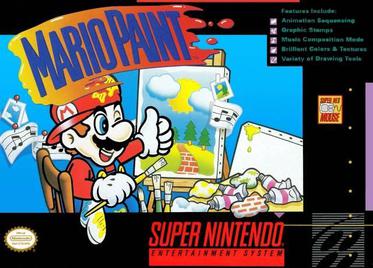

Mario Paint for the Super Nintendo Entertainment System (SNES) is a unique and innovative title that revolutionized the way players interacted with their consoles. Developed and published by Nintendo in 1992, this game introduced players to a whole new level of creativity and fun. With its intuitive controls and diverse features, Mario Paint opened the door to endless possibilities and became a staple in the world of console creativity. Let's dive into this exciting game and explore its various aspects.
Year: 1992
Manufacturer: Nintendo
Genre: Miscellaneous
Rating: Other - NR (Not Rated)
Graphics and Sound:
Mario Paint may not push the SNES's graphical capabilities to their limits, but its charming and simplistic visuals perfectly suit the game's purpose. The interface is clean and easy to navigate, allowing players to focus on their creative endeavors. The colorful and expressive sprites of Mario and his friends add a delightful touch to the overall experience.
Accompanied by a catchy soundtrack, Mario Paint keeps players engaged with its fun tunes that match the game's light-hearted atmosphere. The sound effects are simple yet satisfying, especially when creating and manipulating various objects. Although not groundbreaking, the graphics and sound of Mario Paint blend well to provide an enjoyable aesthetic.
Gameplay:
At its core, Mario Paint is a powerful creativity tool disguised as a video game. The game offers a diverse range of tools and features that allow players to explore their artistic talents. From creating pixel art and animations to composing music and editing videos, Mario Paint is a complete package of artistic tools that make the most of the SNES's capabilities.
One of the game's highlights is the innovative mouse peripheral, which comes bundled with the game. This mouse enables precise control and makes the creative process intuitive and enjoyable. The intuitive interface and well-designed tools, such as the stamp collection and the animation editor, empower players to bring their ideas to life easily.
Another notable feature is the inclusion of various mini-games. These mini-games, while simple in nature, provide a fun break from the creative process. They offer challenges that test players' reflexes and dexterity, adding a layer of entertainment to the overall experience.
Replay Value:
The replay value of Mario Paint largely depends on the player's inclination towards creativity. For those who enjoy unleashing their artistic side, the game offers countless hours of entertainment and experimentation. The robust toolset, combined with the freedom to create and explore, ensures that players can continuously find new ways to express themselves.
Additionally, the game's mini-games provide an extra incentive for replayability, as they offer a welcome diversion from the creative process. Whether it's chasing flies with a swatter or guiding a turtle across a tightrope, these mini-games offer simple yet addictive gameplay that keeps players coming back for more.

Conclusion:
Mario Paint for the SNES is a remarkable game that pushes the boundaries of creativity on a console. With its user-friendly interface, diverse toolset, and intuitive controls, it allows players of all ages to explore their artistic abilities and create masterpieces. While it may not offer a traditional gaming experience, the game's unique blend of creativity and entertainment sets it apart from the rest.
Whether you're an aspiring artist or simply seeking a break from traditional gaming, Mario Paint delivers an engaging and satisfying experience. It's a timeless classic that continues to inspire players to this day, making it a must-have title for any SNES enthusiast. So grab your mouse, let your imagination soar, and prepare to embark on an artistic journey like no other with Mario Paint!
Explore in-depth reviews and analyses of classic Super Nintendo Entertainment System (SNES) games, including gameplay mechanics, graphics, sound, and overall nostalgic experience.